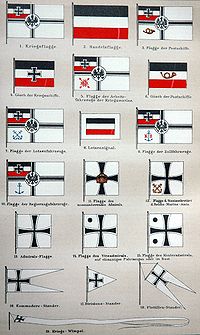Portal:Heraldry
Welcome to the Heraldry and Vexillology Portal!


Heraldry encompasses all of the duties of a herald, including the science and art of designing, displaying, describing and recording coats of arms and badges, as well as the formal ceremonies and laws that regulate the use and inheritance of arms. The origins of heraldry lie in the medieval need to distinguish participants in battles or jousts, whose faces were hidden by steel helmets.
Vexillology (from the Latin vexillum, a flag or banner) is the scholarly study of flags, including the creation and development of a body of knowledge about flags of all types, their forms and functions, and of scientific theories and principles based on that knowledge. Flags were originally used to assist military coordination on the battlefield, and have evolved into a general tool for signalling and identification, particularly identification of countries.
Selected biography

Emilio Aguinaldo y Famy (March 22, 1869 – February 6, 1964) was a Filipino general, politician, and independence leader. He played an instrumental role in Philippine independence during the Philippine Revolution against Spain and the Philippine–American War that resisted American occupation. He designed the flag of the Philippines. (more...)
Selected coat of arms
The coat of arms of Singapore is the heraldic symbol representing the Southeast Asian island nation of Singapore. It was adopted in 1959, the year Singapore became self-governing within the British Empire. At the centre of the emblem is a red shield bearing a white crescent (a new moon, representing a rising young nation) and five white stars (representing various national ideals including multiculturalism). While the use of the coat of arms is restricted to the government, the symbol enjoys wide use on the national currency and state decorations, and appears on the cover of the national passport.(more...)
Selected flag

The Cubs Win Flag is a victory flag that is flown at Wrigley Field after every Chicago Cubs home win. The flag is variously referred to by approximately a dozen names, combining; either Cubs or Chicago Cubs; Win, W, White, White W, or W Win; and flag, banner or banner flag. It has become an important symbol for fans that one retailer describes as a fan banner instead of flag, or banner flag. In addition, days when the win flag is flown are known as "White Flag Days". The tradition of flying a win or loss flag over the stadium began soon after the construction of the scoreboard in 1937.
The flag has used two different color schemes with the letter "W" on a solid background, and there is a loss indicator flag with a letter "L". Additionally, the flags have been complemented by different color schemes of indicator lights. The flag has become a very symbolic emblem for devout Cubs fans. Some retailers sell slightly different versions that also have the Cubs logo at the bottom. (more...)
Selected picture

Flags used by the German Kaiserliche Marine (Imperial Navy), 1892.
Did you know...
- ...that the Dannebrog (pictured) is the oldest state flag in the world still in use, with the earliest undisputed source dating back to the 14th century?
- ...that Somerset Herald John Charles Brooke's parents originally sent him to London to study as a chemist?
- ...that the Seal of the Federal Bureau of Investigation was first used on January 1, 1941?
- ...that the Flag of Federal Territory, Malaysia, was adopted on May 23, 2006?
- ...that the Canadian Heraldic Authority was established by Queen Elizabeth in 1988?
Related portals
|
|
|
Heraldry Web resources
Authorities
- Belgium - The Council of Nobility, Flemish Heraldic Council and Council of Heraldry and Vexillology of the French Community
- Canada - Canadian Heraldic Authority and see also Public Register of Arms, Flags and Badges
- England, Wales, and Northern Ireland - The College of Arms
- Ireland - The Office of the Chief Herald of Ireland
- Netherlands - High Council of Nobility
- Portugal - Instituto da Nobreza Portuguesa
- Scotland - The Court of the Lord Lyon
- South Africa - South African Bureau of Heraldry
- Sweden - National Board of Heraldry, The National Archive
- United States Army - The United States Army Institute of Heraldry
Societies
- Greek Heraldry Society
- The Academy of Heraldic Science Czech republic
- The American College of Heraldry
- The American Heraldry Society
- The Augustan Society
- The Australian Heraldry Society Inc.
- Bulgarian Heraldry and Vexillology Society
- The Center for Research of Orthodox Monarchism
- Cambridge University Heraldic and Genealogical Society
- Chiltern Heraldry Group
- The College of Dracology
- Croatian Heraldic and Vexillologic Association
- The Finnish Heraldic Society
- Fryske Rie foar Heraldyk
- Hellenic Armigers Society
- Guild of Heraldic Artists
- Genealogical Society of Ireland
- Heraldry Research Institute (Japan)
- The Heraldry Society
- The Heraldry Society of Africa
- The Heraldry Society of New Zealand Inc.
- The Heraldry Society of Scotland
- The Heraldry Society of Southern Africa
- The Institute of Heraldic and Genealogical Studies
- The International Association of Amateur Heralds
- Italian Center of Vexillological Studies
- Lancashire Heraldry Group
- Macedonian Heraldry Society
- New England Historic Genealogical Society Committee on Heraldry
- Norwegian Heraldry Society
- Oxford University Heraldry Society
- Polish Heraldry Society
- Polish Nobility Confederation
- Real Academia Matritense de Heráldica y Genealogía - Royal Academy of Heraldry and Genealogy of Madrid
- Romanian Institute for Genealogy and Heraldry
- The Royal Heraldry Society of Canada
- The Russian College of HeraldryThe Russian College of Heraldry
- Serbian Heraldic Society
- Societas Heraldica Scandinavica
- Societas Heraldica Slovenica
- Swedish Heraldic Society
- Ukrainian Heraldry Society
- Royal Association Genealogical and Heraldic Office of Belgium
Vexillology
Software
- Coat of Arms Visual Designer web-based program
- Puncher Heraldry Program
- Blazonry Server - pyBlazon
- DrawShield - creates SVG shield or arms image from blazon
- CoaMaker - web-based tool
- Blazon95 and BLAZONS! 2000, older Windows applications
Texts
- Heraldry, historical and popular : with seven hundred illustrations (1863)
- A Complete Guide to Heraldry (1909)
Other
Wikimedia
The following Wikimedia Foundation sister projects provide more on this subject:
-
Commons
Free media repository -
Wikibooks
Free textbooks and manuals -
Wikidata
Free knowledge base -
Wikinews
Free-content news -
Wikiquote
Collection of quotations -
Wikisource
Free-content library -
Wikispecies
Directory of species -
Wikiversity
Free learning tools -
Wikivoyage
Free travel guide -
Wiktionary
Dictionary and thesaurus












